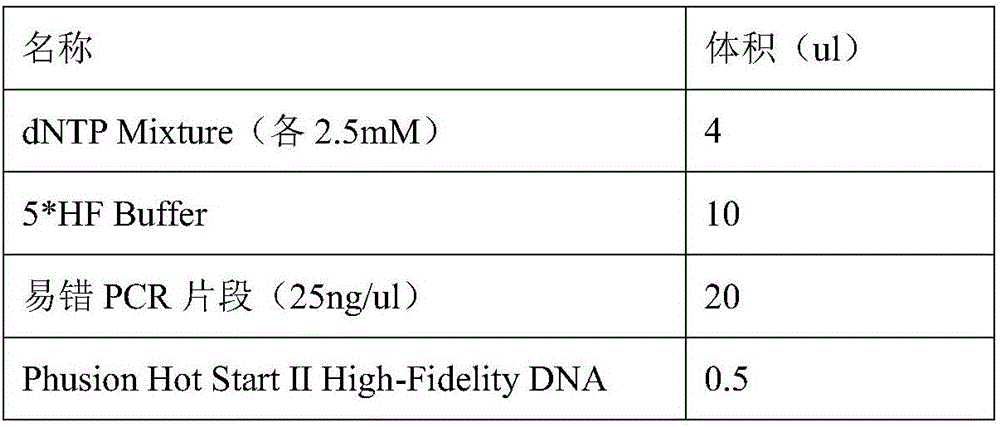Glucose 6 phosphate dehydrogenase mutant
A phosphate dehydrogenase and mutant technology, applied in the directions of enzymes, oxidoreductases, enzymes, etc., can solve the problems of poor label stability, poor stability, shortened validity period of the kit, etc., and achieve good thermal stability and inhibition. The effect of high rate and specific enzyme activity
- Summary
- Abstract
- Description
- Claims
- Application Information
AI Technical Summary
Problems solved by technology
Method used
Image
Examples
Embodiment 1
[0036] Mutation library construction
[0037] 1. For the sequence shown in Sequence 2, use the method of total gene synthesis to synthesize (remove the stop codon), and clone it into the pET-22b vector, and the restriction sites used are NdeI and XhoI. The plasmid pET-G6PD thus obtained was used as a template for the following error-prone PCR and WHOP-PCR.
[0038] 2. Error-prone PCR reaction system and conditions
[0039] Table 1 The reaction system is 100ul:
[0040] name
Volume (ul)
dNTP Mixture (2.5mM each)
8
dTTP (100mM)
0.8
dCTP (100mM)
0.8
10*PCR Buffer
10
Upstream primer (5mM), SEQ ID NO: 3
20
Downstream primer (5mM), SEQ ID NO: 4
20
MnCl 2 (5mM)
10
Mg 2+ (25mM)
14
Taq enzyme (5U / ul)
1
Template (10ng / ul)
5
water
12
[0041] The reaction conditions are:
[0042] 95°C for 5min; 94°C for 30sec; 55°C for 30sec; 72°C for 2min; 30 cycles; 72°...
Embodiment 2
[0055] Screening of mutant libraries
[0056] 1. Culture, induction and expression
[0057] After mixing the obtained clones with a coating rod, they were collected in a centrifuge tube, and the plasmids were extracted, and the obtained plasmids were transformed into BL21(ED3) for the next step of screening. Next, the above-mentioned transformant was inoculated in a 96-well plate, wherein the last well was inoculated with the wild-type strain as a control, and the medium used was 150ul LB / well containing ampicillin antibiotic, and the orifice plate was used as a retention plate. The next day, transfer to another 96-well plate in the same order. The medium used is 150ul LB / well, and ampicillin antibiotics and IPTG are added for induction at the same time. Cultivate at 37°C for 6 hours, centrifuge at 3800rpm to collect bacteria, and remove the medium , the orifice plate is used as the analysis plate.
[0058] 2. Screening
Embodiment 3
[0062] Enzyme Activity Determination and Thermal Stability Analysis of Glucose 6-Phosphate Dehydrogenase
[0063] The purified glucose-6-phosphate dehydrogenase was diluted to about 0.1 ug / ml in 100 mM Tris, pH 8.0 buffer.
[0064] Take 50ul of the glucose 6-phosphate dehydrogenase in a 96-well PCR, select 8 gradients in the range of 40-50°C for heat treatment for 30min, and store at 4°C.
[0065] Transfer 50ul of heat-treated glucose 6-phosphate dehydrogenase to a 96-well plate, and at the same time take 50ul of unheated glucose 6-phosphate dehydrogenase on the same 96-well plate. Incubate at 37°C for 10 minutes.
[0066] Add the reaction solution (Tris, 100mM, pH7.4; glucose solution, 100mM; NADP, 5mM; ATP, 5mM; MgCl 2 , 5mM; hexokinase, 10KU / L; BSA, 0.05mg / ml), react at 37°C for 30min.
[0067] The absorbance at 340 nm was recorded using a microplate reader.
[0068]Divide the absorbance value of the heat-treated glucose 6-phosphate dehydrogenase by the absorbance value...
PUM
 Login to View More
Login to View More Abstract
Description
Claims
Application Information
 Login to View More
Login to View More - R&D
- Intellectual Property
- Life Sciences
- Materials
- Tech Scout
- Unparalleled Data Quality
- Higher Quality Content
- 60% Fewer Hallucinations
Browse by: Latest US Patents, China's latest patents, Technical Efficacy Thesaurus, Application Domain, Technology Topic, Popular Technical Reports.
© 2025 PatSnap. All rights reserved.Legal|Privacy policy|Modern Slavery Act Transparency Statement|Sitemap|About US| Contact US: help@patsnap.com



